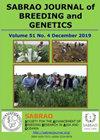OPTIMIZATION OF WINTER WHEAT NUTRITION WITH ZERO TILLAGE TECHNOLOGY IN THE RAINFED ZONES OF SOUTHERN KAZAKHSTAN
IF 1.7
Q3 PLANT SCIENCES
引用次数: 0
Abstract
The promising research showcased the results of herbicides’ uses, considering the quantitative composition of weeds with zero tillage technology of winter wheat cultivation. It revealed that when treating wheat seeds with the growth stimulator Vimpel (0.5 l/t) and micro-fertilization with Oracle (1.0 l/t) simultaneously etching with the fungicide Bunker (0.4 l/t), as well as, early spring treatment of crops in the tillering phase of winter wheat with the same stimulator (Vimpel, 0.5 l/ha) and micro-fertilization (Oracle multicomplex, 2.0 l/ha) simultaneous with the herbicide “Ballerina” (0.5 l/ha) application, the number of preserved plants before harvesting was 286.1 pcs./m2, reaching a height of 88.9 cm, with a productive bushiness of 1.15 pcs., grains per spike (22.2), 1000-grain weight (34.8 g), and collected dry grains at a standard humidity (22.1 c/ha). It was also evident that the competitive productivity of winter wheat also emerged when treating wheat seeds with biological fertilizer Biobars–M (1.0 l/t), the crop at the tillering stage with Biobars–M (0.5 l/ha), and the earring phase (0.7 l/ha). Similarly, using growth stimulants Vimpel and micronutrient Oracle multicomplex enhanced the grain yield with reduced cost of production (USD 61.3–66.0/kg) compared with the control version (USD 78.6 /kg). On one hectare of winter wheat crop, the net income ranged from USD 289.55 to 443.56.哈萨克斯坦南部雨养区冬小麦免耕营养优化研究
从冬小麦免耕栽培的杂草数量组成来看,这一前景广阔的研究展示了除草剂的应用成果。结果表明:用Vimpel (0.5 l/t)促生长剂和Oracle (1.0 l/t)微施肥同时施用杀菌剂Bunker (0.4 l/t)处理小麦种子,以及在冬小麦分蘖期用相同的促生长剂(Vimpel, 0.5 l/ha)和Oracle复合微施肥(2.0 l/ha)同时施用除草剂“Ballerina”(0.5 l/ha)处理作物早春,收获前保存的植物数量为286.1株。/m2,高88.9 cm,产量1.15 pcs。每穗粒数(22.2),千粒重(34.8 g),在标准湿度(22.1 c/ha)下采集干粒。在分蘖期施用生物肥料Biobars-M (1.0 l/t)、分蘖期施用生物肥料Biobars-M (0.5 l/ hm2)和抽穗期施用0.7 l/ hm2时,冬小麦的竞争生产力也明显提高。同样,与对照版本(78.6美元/公斤)相比,使用生长刺激剂Vimpel和微量营养素Oracle复合剂提高了粮食产量,同时降低了生产成本(61.3-66.0美元/公斤)。每公顷冬小麦的净收入在289.55美元至443.56美元之间。
本文章由计算机程序翻译,如有差异,请以英文原文为准。
求助全文
约1分钟内获得全文
求助全文
来源期刊

Sabrao Journal of Breeding and Genetics
农林科学-奶制品与动物科学
CiteScore
1.90
自引率
50.00%
发文量
63
期刊介绍:
The SABRAO Journal of Breeding and Genetics is an international journal of plant breeding and genetics research and was first published in 1969. It is the official publication of the Society for the Advancement of Breeding Research in Asia and Oceania (SABRAO).
Its objectives are to: promote the international exchange of research information on plant breeding and genetics, by describing new research findings, or ideas of a basic or practical nature; and be a medium for the exchange of ideas and news regarding members of the Society.
The Journal gives priority to articles that are of direct relevance to plant breeders and with emphasis on the Asian region. Invited for publication are research articles, short communications, methods, reviews, commentaries, and opinion articles. Scientific contributions are refereed and edited to international standards.
The journal publishes articles for SABRAO members mainly. The Journal preferred strongly that at least one author should be a current member of the Society. Non-members may also publish in the journal.
 求助内容:
求助内容: 应助结果提醒方式:
应助结果提醒方式:


